CCEE Laboratories
Civil, Construction and Environmental Engineering department has excellent laboratory facilities for undergraduate education and research, including the new undergraduate laboratories for water resources and environmental engineering, laboratories for geotechnical engineering and civil engineering materials, and several state-of-the-art research laboratories. A list, along with the brief details of the department laboratories are as follows:
Advanced Geo/Structural Laboratory
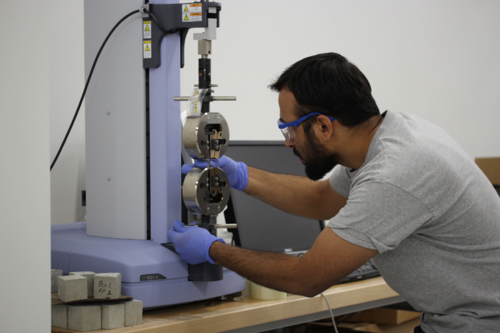
This laboratory is housed in Ehly Hall (Room 110). This laboratory has one environmental chamber, one curing room, and one strong floor/wall. The laboratory was set up in Fall 2016, which is an excellent and necessary addition to the structural thrust of NDSU. It provides a capability to perform the curing of concrete samples and evaluate the environmental effect on structural members, and provides basis for future large-scale testing of structural members and systems. The laboratory also hosts the Express 8 System (the acoustic emission board and system) and the 2KN Shimadzu compression and tension testing machine, which could help to sense the conditions of structural members and systems and test the mechanical behavior of soft materials, biological tissues and 3D printed polymer products. This machine currently has one set of wedge grips and additional custom made grips for testing 3D printed cubes.
Laboratory Equipment
Some of the major pieces of equipment in the laboratory are listed below.
- Express 8 acoustic emission board and system
- Inverted Trinocular Metallurgical Microscope & Camera
- NANO 1000T Grinder & Polisher
- 54621A2 Channel 60-MHz Magazoom Oscilloscope
- 33220A 20 MHz Function/Waveform Generator
- 2KN Shimadzu tension/compression and cyclic testing system.
Advanced Materials Laboratory
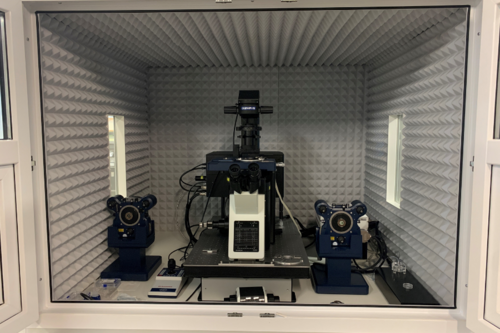
The laboratory is housed in Ehly Hall (Room 118). This laboratory houses equipment used for nanotechnology and nanomaterials research and education. Most of the equipment items in this laboratory have been procured in the last ten years through two National Science Foundation equipment grants: the Instrumentation for Materials Research grant and the Major Research Instrumentation grant.
Laboratory Equipment
The major pieces of equipment are listed below:
- FTIR Microspectroscopy Bench (Thermo Electron)
- Photoacoustic Spectroscopy (MTEC)
- Atomic Force Microscope (Veeco)
- Nanoindentation – Load and displacement control and mapping (Hysitron)
- Nanodynamic Instrumentation (Hysitron)
- Optical Microscope
- High Precision diamond saw with goniometer (Isomet-Buehler)
- Spin Coater (Chemat)
- Sonicator
- Vacuum Oven
CEE Computer Cluster
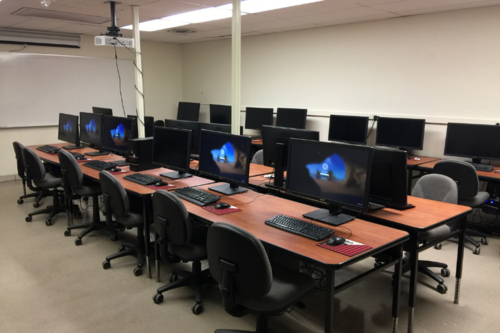
A dedicated civil engineering computer cluster with 21 computers is housed in CIE 106. This facility is available 24 hours a day and 7 days a week via secure card key access. Only civil engineering students have access to the facility. The students use a variety of software for their courses. This dedicated computer cluster is also essential for instruction in the software-related modeling courses. The software packages in the cluster represent those commonly used in different areas of civil engineering. In addition, the Microsoft suite of programs is available including Word, PowerPoint and Excel. Graduate students normally have individual computers in their offices and may occasionally use this cluster for specific software or specialized printing. In addition, students can use AutoCAD and other software packages in the university-supported computer clusters.
Students can utilize the cloud-based storage (e.g., Microsoft OneDrive and Google Drive) and network drives to securely store and share data online. They can access their data from any networked computer or wireless enabled laptop. Such resources provide opportunities for students to work remotely and collaboratively. In addition, laptop computers and projectors are available in the department for student presentations. The College of Engineering has dedicated personnel to support the college-wide IT infrastructure, in addition to the NDSU IT services.
Laboratory Equipment/Software
The major pieces of equipment/software are listed below:
- Desktop Computers with centralized Printers
- Abaqus
- ANSYS
- AutoCAD with Civil 3D, Revit, Architecture, MEP and Map 3D
- Bentley Systems products
- BioWin
- ESRI ArcGIS
- Microsoft Office Professional
- RISA-3D structural engineering software
- SolidWorks products
- WinPas Software for Pavement Design
- Watershed Modeling System (WMS)
- HEC-HMS
- HYDROL-INF
- WinTR-55
- BASINS
Concrete Laboratory
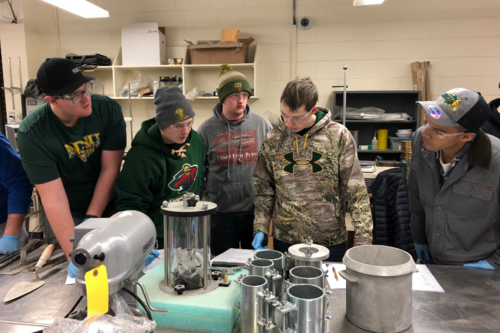
The Concrete and Soil Testing laboratory is located at CIE 108A. For the preparation of various soil and concrete tests for construction management and engineering applications, as well as testing recommendations for undergraduate and graduate research, the laboratory follows ASTM standards. In the Spring semester, this lab is used in CME 260: Soils and Foundations and CME 453: Concrete Design and Construction courses.
Laboratory Equipment
The major pieces of equipment in the laboratory are listed below:
- Humboldt H-3175 Sonometer Resonance Frequency Test
- Forney Compressive Test Apparatus
- Forney Rotary Lab Sifter
- Triaxial Loader Test Apparatus
- 2-Cell Control Panel for Permeability Testing
- Slump Tests Sets
- Freeze Thaw Cabinet, Elite Series
- Concrete Air Meters
- Self-Consolidation Concrete(SCC) Segregation Test Set
- Precision Tank Heater
- Atterberg Limit Test Sets
- Ovens
- Concrete Mixers
- Sieve Sets
- Pressure Gauge
Environmental Laboratory
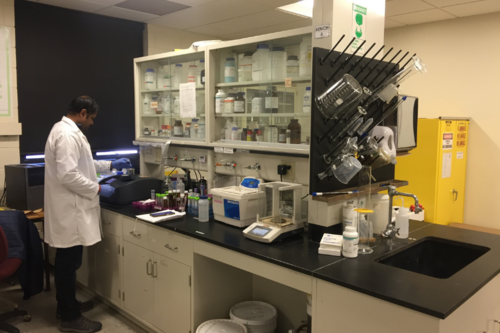
The Environmental Laboratory is located in CIE 214 and the adjacent rooms. The laboratory is primarily used for environmental engineering research with specific emphasis on water and wastewater. The laboratory is designed for undergraduate and graduate research. It is also used for a few technical elective classes depending on the need for specialized experiments (e.g., running treatability studies in CE 471/671 Environmental Nanotechnology and CE 479/679 Advanced Water and Wastewater Treatment). The adjacent instrument room is for large analytical instruments. There are four other small rooms, one of which is used for chemical storage, one for other storage, and two as graduate student offices.
Laboratory Equipment
The major pieces of equipment in the laboratory are listed below:
- A GC System
- A total organic carbon (TOC) Analyzer
- Graphite Furnace Atomic Adsorption Spectrometer (AAS)
- Spectrophotometers
- Turbid meters
- pH Meters
- Dissolved oxygen (DO) Meters
- Ozone Generator and Control System
- Respirometers
- Microscopes
- Conductivity Meters
- Distillation and Digestion Systems for sample preparation
- Vacuum pumps
- Ovens
- Ion-selective Electrodes
- Muffle Furnace
- Weighing Balances
Fluid Mechanics STEM Teaching Laboratory
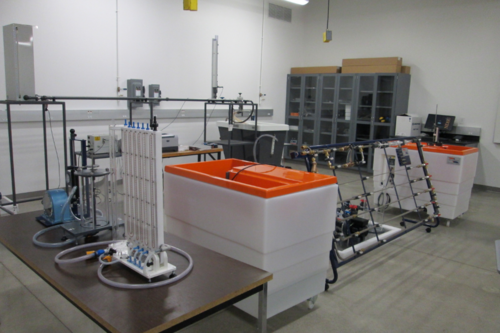
The Fluid Mechanics STEM Teaching Laboratory is located in the A. Glenn Hill Center (AGHill 114). This new teaching laboratory is well equipped for serving the CE undergraduate curriculum. Most equipment and instruments (e.g., C6-MKII-10 Fluid Friction Measurements and A-12 Hydraulic Demonstration Channel) in the laboratory are new. The laboratory has equipment for demonstrating and verifying fundamental principles of fluid mechanics (statics, kinematics, and dynamics). It also has several devices for measuring both pipe flow and channel flow.
Laboratory Equipment
The major pieces of equipment in the laboratory are listed below:
- Pipe Surge and Water Hammer (H405)
- Two-Channel Oscilloscope (H405a)
- Volumetric Hydraulic Bench (H1D)
- Series & Parallel Pump Test Set (H32)
- Liquid Sedimentation Apparatus (H3111)
- A-12 Hydraulic Demonstration Channel
- Open Tank Settings
- Bourdon Gauge (201)
- Fluid Friction Measurements (C6-MKII-10)
Geotechnical Engineering Laboratory
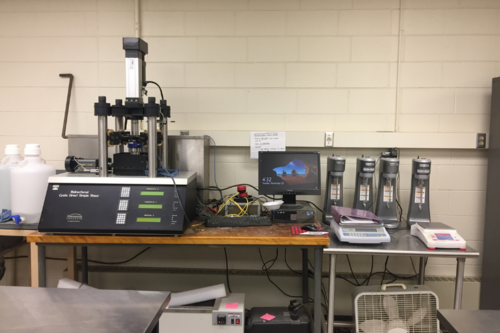
The geotechnical (soil mechanics) laboratory has capabilities for conducting all conventional tests including moisture content, grain size analysis, hydrometer, compaction tests, specific gravity, Atterberg limits, permeability, direct shear and consolidation tests. The laboratory hosts a direct shear machine with electronic transducers for data acquisition. The system has a full set of dial gauges for manual recording of data. In addition, there are four bench top consolidometers with electronic displacement transducers and four permeameters, with each having dial gauges for manual recording of data. The permeameters are used for conducting both constant head and falling head permeability tests. Some additional pieces of equipment including digital balance, hydrometers, glassware and miniature transducers for measuring pore water pressure, load, and acceleration are also available in the laboratory.
The triaxial test system consists of a computer controlled load frame from SATEC (Model 22EMF) with a new Instron controller and integrated with triaxial cells and a high-speed data acquisition system. Other associated instrumentation includes three pore water pressure transducers, a submersible load cell, axial transducer, and a digital volume change transducer. The system also includes a deairing cell for producing deaired water, a dedicated air compressor and a vacuum pump.
Laboratory Equipment
Some of the major pieces of equipment in the laboratory are listed below.
- Triaxial test system
- Dynamic load frame
- Direct Shear Apparatus
- Consolidometers
- Permeameters
- Hydrometers
- Sieve sets
- Atterberg limits
Hydrologic Modeling Laboratory
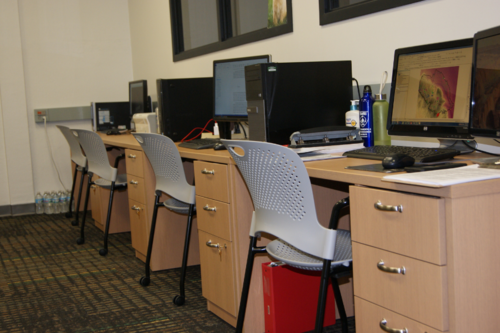
The Hydrologic Modeling Laboratory is located in CIE 104. The equipment and facilities in the laboratory (both hardware and software) are mainly funded by the National Science Foundation (NSF) under the CAREER grant EAR-0907588 and the EPSCoR grant IIA-1355466. The laboratory is primarily used for hydrologic modeling research, graduate and undergraduate student training, and the relevant outreach activities. The laboratory facilities a variety of modeling research with focus on multi-scale hydrologic modeling, topographic characterization, GIS data analysis, and water quality modeling. It also supports undergraduate and graduate course teaching efforts (e.g., CE 476/676 Watershed Modeling and CE 477/677 Applied Hydrology). This laboratory is mainly used for hydrologic modeling and hydrologic data analysis. The specific research activities include: development of various hydrologic models, development of various modeling software packages and analysis tools, and applications of water quantity and quality modeling in North Dakota.
Laboratory Equipment
The major pieces of equipment in the laboratory are listed below:
- Dell Workstations, Precision Tower 7910 XCTO Base
- Personal Computers
Infrastructure Sensors Laboratory
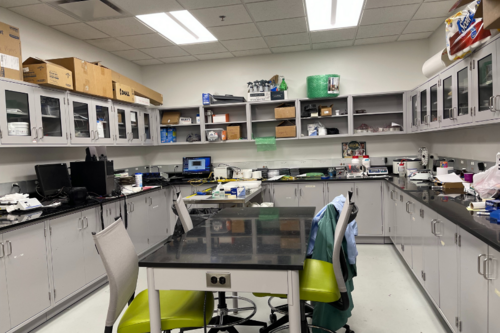
The laboratory is used for teaching and conducting research on basic sensor development and testing. This laboratory is designed for both undergraduate/graduate teaching and research. It can accommodate one group of five students allowing hands-on activity for each student. The laboratory is used for CE 782 Introduction to Intelligent Infrastructure, which is offered in spring semesters. The course consists of two experimental sessions. In the experimental sessions, students learn to install strain gauges, test strain gauges, and perform related data analysis. In addition, more than four research projects are also conducted in the laboratory.
Laboratory Equipment
Some of the major pieces of equipment in the laboratory are listed below.
- An optical signal analyzer (Ando_AQ6330)
- A broadband light source (Agilent 83437)
- An optic fiber fusion kits (Sumitomo Fusion Splicers Type-35)
- A RMS bench digital multimeter
- Two optical fiber cleaver
- A high-frequency fiber Bragg grating sensor integrator
- A D-4 strain gauge data acquisition conditioner
Materials Laboratory
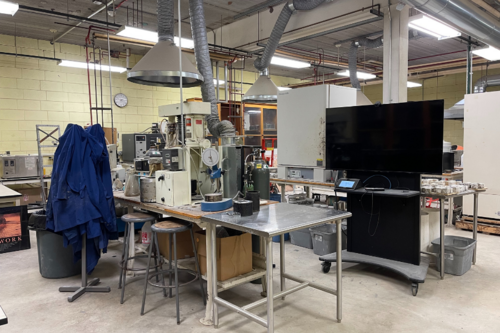
The laboratory is used for teaching the basics of hot mix asphalt and Portland cement concrete, two major construction materials used in the civil engineering and construction industries. Recently, the laboratory was upgraded with advanced equipment for bituminous materials and mixture testing. Some of the laboratory equipment items are also used for the soil mechanics (geotechnical) laboratory.
Laboratory Equipment
Some of the major pieces of equipment in the laboratory are listed below.
- Superpave Gyratory compactor for the design of hot asphalt
- Dynamic Shear Rheometer (DSR) for testing asphalt binders
- Bending Beam Rheometer (BBR) for testing asphalt binders
- Pressure Aging Vessel (PAV) for aging asphalt binders
- Rotary Thin Film Oven (RTFO) for aging asphalt binders
- High Speed Mixer and Shearing asphalt additives
- Marshall hammer for preparing hot mix asphalt samples
- Marshall breaking machine for testing hot mix asphalt samples
- Sieves and screens for determining aggregate particle sizes
- Ovens for heating and drying aggregates
- Satec compression machine for testing concrete cylinders
- Other miscellaneous equipment for mixing concrete and casting concrete cylinders
Nano Impact Laboratory
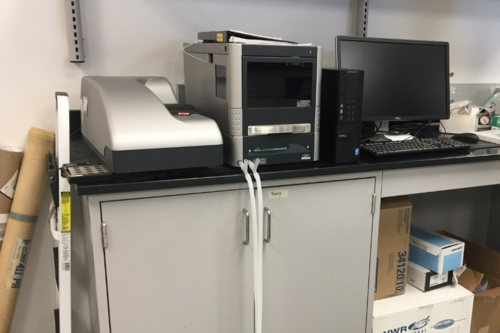
The Nano Impact Laboratory (NILab) is located in Ehly 106 and used for conducting research on applications of nanomaterials and their impacts on the ecosystem components. The laboratory is designed for undergraduate and graduate research. Students in technical elective classes (e.g., CE 471/671 Environmental Nanotechnology) use this laboratory for nano-related experiments. Workspace is available in this laboratory, allowing ample hands-on activities for each student. Two custom-base plant growth chambers (mini-greenhouses) are located in the laboratory. The attached small room is used for cell culture and microbiological experiments.
Laboratory Equipment
The major pieces of equipment in the laboratory are listed below:
- Spectrophotometers
- Turbidimeters
- Malvern Zetasizer with Nano Sampler
- Voltammetry (VA computrace Metrohm)
- Controlled environment Plant Growth Chambers (Small greenhouse)
- Environmental Chamber
- Fridge for sample storage
- Sonication Bath
- Biological Safety Cabinet
- Fume Hood
Structures Laboratory
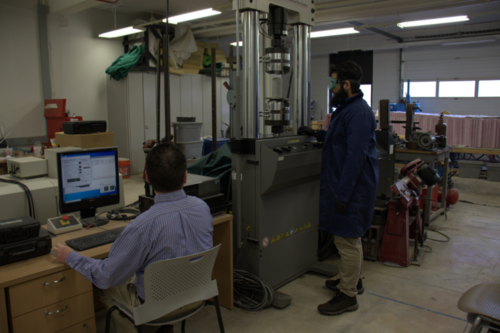
The structures laboratory is used for teaching the basics of tension test and serves as the office for the ASCE student chapter. The structures laboratory is also used for steel bridge and concrete canoe manufacturing and practicing. Recently, the laboratory was upgraded with an MTS 809.10 Axial Torsional Test System Assembly, which has been widely used for research in structures and materials field.
Laboratory Equipment
Some of the major pieces of equipment in the laboratory are listed below.
- 250-kip compression testing machine
- Environmental chamber
- 22-kips MTS tension/compression and torsion testing system
Surveying Laboratory
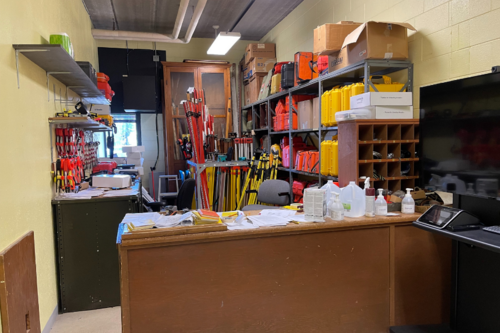
The laboratory has capabilities for teaching the basics of plane surveying as it pertains to civil engineering and construction. Sufficient equipment is available to outfit 17 groups of three students each. Thus, the laboratory sections are limited to about 50 students.
Laboratory Equipment
Some of the major pieces of equipment in the laboratory are listed below.
- Automatic levels
- Engineers transits
- Electronic distance measuring instrument (EDM)
- Total station with data collector
- Total station without data collector
- Laser level
- Other miscellaneous equipment such as rods, chains and plumb bobs
Tissue Engineering Laboratory
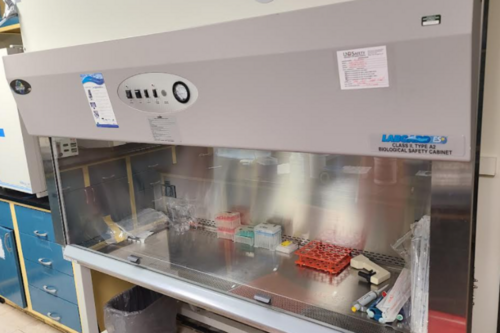
This laboratory is housed in the Geociences building (Room 102). This laboratory has equipment for the cell culture facilities required for tissue engineering. The laboratory was set up in Spring 2006 and all equipment was funded by research equipment grants. This laboratory is an excellent and necessary addition to the Biomaterials thrust of NDSU. It provides a capability to do cell adhesion studies on how human cells adhere and proliferate in synthetic materials made to replace human tissues. The tissue engineering thrust deals with the design of mechanically strong scaffolds that are seeded with cells with the idea that new tissue can be generated by the human body that is synthetic and living. This field includes both engineering mechanics and biology.
Laboratory Equipment
The major pieces of equipment are listed below:
- Incubator
- Low temperature (-70°C) freezer
- Freezer
- Centrifuge
- Autoclave
- Inverted microscope (Carl Zeiss)
- Biohazard hood
- Electrospinning apparatus
- Liquid nitrogen storage
Transportation Laboratory
A separate space has been dedicated for transportation laboratory within the department. The laboratory space has made it possible to house devices, computers, and assistants to provide a safe, secure, and continuous work related to integrated transportation teaching and research within the department. The efforts in transportation laboratory are also supported by surveying equipment, which are stored in a separate room.
Laboratory Equipment
Some of the major pieces of equipment in the laboratory are listed below.
- Ten additional and newer JAMAR technologies Traffic Data Collection (TDC) devices
- Four video cameras and tripods
- A GPS-based device for travel time study (GPS2LT) and related software (PCTRAVEL)
- Microstation and GEOPAK software
- Highway Capacity Software (HCS), Trafficware’s SYNCHRO and SIMTRAFFIC software, and PTV Vision, Inc.’s VISSIM and VISUM software
Water Resources Engineering Laboratory
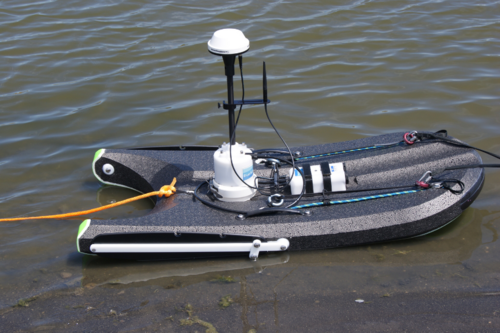
The Water Resources Engineering Laboratory is located in CIE 103 (wet laboratory) and CIE 104A (dry laboratory). The equipment and instruments in this laboratory are mainly funded by the National Science Foundation (NSF) under the CAREER grant EAR-0907588 and the EPSCoR grant IIA-1355466. The laboratory is used for water resources research, graduate and undergraduate education, and the relevant outreach activities. The laboratory facilities a variety of hydrologic monitoring (e.g., rainfall, snow, surface water depths, and stream flow), hydrologic experiments (e.g., infiltration, overland flow, soil water flow, and soil erosion and sediment transport), and quantification of surface microtopography. The laboratory also supports undergraduate and graduate water resources education.
Laboratory Equipment
The major pieces of equipment in the laboratory are listed below:
- Instantaneous-Profile Laser Scanner (with the computer control system)
- Four-head Norton Rainfall Simulator (with 500-gallon tank and pumping system)
- Tipping Bucket Rain Gauge
- ECH2O Soil Moisture Sensors EC-5
- CS655 Water Content Reflectometers
- CR1000 Data Loggers
- Data Loggers Em5b
- Mini-Disk Infiltrometers
- Soil Boxes
- SonTek River Surveyor
- SonTek-IQ
- FH950 Portable Velocity Meter
- Top Setting Wading Rod Kit
- Bluetooth HOBO MX2001 Water Level Data Loggers


